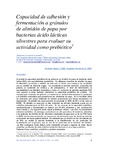| dc.contributor.author | Lamadrid Avendaño, Alejandra | |
| dc.contributor.author | Bernal Gracida, Lilia Angélica | |
| dc.contributor.author | Morales Meza, María Guadalupe | |
| dc.creator | BERNAL GRACIDA, LILIA ANGELICA; 103103 | |
| dc.creator | MORALES MESA, MARIA GUADALUPE; 877088 | |
| dc.date.accessioned | 2019-02-28T03:20:32Z | |
| dc.date.available | 2019-02-28T03:20:32Z | |
| dc.date.issued | 2009-06 | |
| dc.identifier | http://repositorio.lasalle.mx/handle/lasalle/896 | |
| dc.identifier.citation | Lamadrid Avendaño, A., Bernal Gracida, L. A. y Morales Meza, M. G. (2009). Capacidad de adhesión y fermentación a gránulos de almidón de papa por bacterias ácido lácticas silvestres para evaluar su actividad como prebiótico. Revista del Centro de Investigación de la Universidad La Salle, 8(31), 5-21. | es_MX |
| dc.identifier.issn | 1665-8612 | |
| dc.identifier.other | https://doi.org/10.26457/recein.v8i31.180 | |
| dc.identifier.uri | http://revistasinvestigacion.lasalle.mx/index.php/recein/article/view/180/403 | |
| dc.description.abstract | Se evaluó la capacidad prebiótica de los gránulos de almidón de papa en bacterias ácidoláctica (BAL) con características probióticas. Se utilizaron muestras de almidón de papa de diferentes variedades y almidón de maíz que se utilizó para comparar los resultados con un almidón de diferente origen. Se caracterizó el almidón midiendo: el tamaño del gránulo, el contenido de amilosa y de amilopectina, el nivel de fosforilación, la susceptibilidad a la hidrólisis enzimática y ácida y el contenido de almidón resistente (AR)para conocer si estos factores determinan la capacidad prebiótica del almidón. Se encontró que el tamaño de gránulo y el contenido de amilosa determinaron la resistencia a la hidrólisis enzimática que presentaron los almidones de papa. En la hidrólisis ácidalos almidones con mayor contenido de amilosa presentaron una mayor resistencia a la degradación. El almidón de papa presentó en promedio un 80% de AR y el de maíz un 44.6%. El almidón de papa por su alto contenido de almidón resistente puede ser un prebiótico potencial para las BAL del colon. En los ensayos de la capacidad amilolítica, cosedimentación y fermentación se trabajó con 44 BAL silvestres y con Lactobacilluscasei Shirota y Acti regularis como cepas probióticas control. Las BAL no presentaron actividad amilolítica, sin embargo, presentaron un alto porcentaje de bacterias adheridas a los gránulos de almidón de las diferentes variedades de papa que va de un 75% hasta un 99%, siendo esta asociación un mecanismo de protección para las bacterias ante las condiciones del tracto gastrointestinal. No obstante que el almidón no fue hidrolizado por las BAL se realizó el estudio tendiente a la identificación de los productos de fermentación con la glucosa, que es uno de los productos de la hidrólisis del almidón. Las BAL produjeron ácido láctico como metabolito principal y algunas de éstas dieron pequeñas cantidades de ácido butírico metabolito deseado en una cepa probiótica. | es_MX |
| dc.description.abstract | Potato starch granules prebiotic capacity was evaluated in lactic acid bacteria (LAB) with probiotic characteristics. Samples from a variety of potato and maize starch were used to compare results against a starch of different origin. The starch was characterized by measuring the granule size, the amylase and amilopectin content, the phosphorylation level, the susceptibility to enzymatic and acidic hydrolysis, and the content of resistant cotton (RC) to know if these factors determine the starch prebiotic capacity. It was found that the granule size and the amylase content determined the enzymatic hydrolysis resistance showed by the potato starches. In the acidic hydrolysis starches with greater amilose content showed a higher resistance to degradation. The potato starch showed an average of 80% of RC and the one of maize 44.6%. Due to its high content of resistant starch, the potato starch may be a potential prebiotic for the colon’s LAB. During the essays of amylolithical capacity, co-sedimentation, and fermentation 44 wild LAB and Lactobacillus casei Shirota and Acti regularis were used as probiotic control stocks. LAB did not present amylotithical activity; nevertheless, they presented a high percentage of adhered bacteria to the starch granules of the several potato varieties that goes from 75% to 99%, being this association a mechanism of protection for bacteria for the gastrointestinal tract conditions. Although the starch was not hydrolyzed by LAB a study tending to identify glucose fermented products was performed, which is one of the products of the starch hydrolysis. LAB produced lactic acid as the main metabolite and some of these produced small amounts of desired metabolite butyric acid in a probiotic stock. | es_MX |
| dc.format | application/pdf | es_MX |
| dc.language.iso | spa | es_MX |
| dc.publisher | Universidad La Salle México, Dirección de Posgrado e Investigación | es_MX |
| dc.relation | http://revistasinvestigacion.lasalle.mx/index.php/recein/article/view/180/119 | |
| dc.rights | Acceso abierto | es_MX |
| dc.rights.uri | http://creativecommons.org/licenses/by-nc-nd/4.0/ | * |
| dc.subject | Prebiótico | es_MX |
| dc.subject | Probiótico | es_MX |
| dc.subject | Almidón resistente | es_MX |
| dc.subject | Preboitic | es_MX |
| dc.subject | Probiotic | es_MX |
| dc.subject | Resistant starch | es_MX |
| dc.subject.classification | BIOLOGÍA Y QUÍMICA::QUÍMICA::BIOQUÍMICA::ALMIDÓN | es_MX |
| dc.subject.other | Química | es_MX |
| dc.title | Capacidad de adhesión y fermentación a gránulos de almidón de papa por bacterias ácido lácticas silvestres para evaluar su actividad como prebiótico | es_MX |
| dc.type | article | es_MX |
| dc.identificator | 2||23||2302||230228 | es_MX |
| dc.audience | generalPublic | es_MX |







